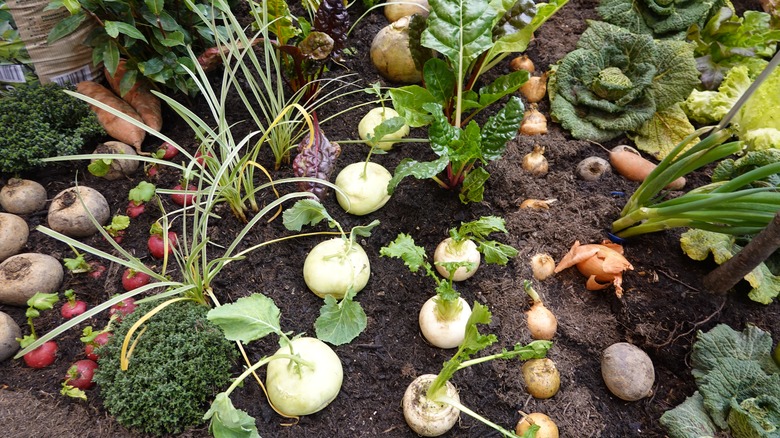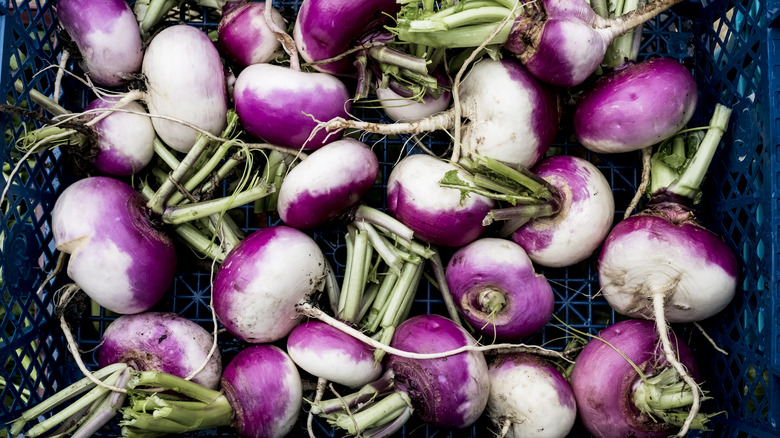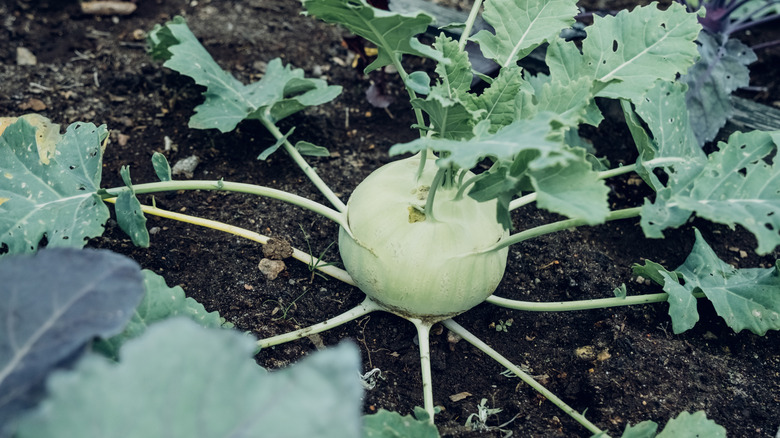What's The Difference Between A Turnip And A Kohlrabi?
To an uneducated eye, the unique appearances of both the turnip and kohlrabi may lead one to believe they are the same vegetable, perhaps at different stages of growth. This is not an uncommon misconception, as they both fall under the cruciferous category, referred to as such because of their cross-like flowers. Their shared genus, Brassica, causes them to sport a very similar look with a bulbous shape, long stalk, and shades of purple, white, or green. However, though they're both root vegetables, they are extremely different in many ways.
At a closer look, a prospective shopper should easily be able to tell a turnip and a kohlrabi apart. While turnips are often white with a purple or red top, kohlrabi have more even coloring. Both kohlrabi and turnips have multiple stems jutting from their tops, but kohlrabi is distinctive because of how spread out its stems can be. Although they share many similarities in appearance, taste, and benefits, a deeper look at the two will alert any prospective chef to the unique qualities that make these vegetables so different.
The truth about turnips
It's thought that turnips originated in Europe or Asia, but one of their biggest claims to fame came during the Roman Empire. Throughout this period, turnips were a popular vegetable within impoverished communities. And, prior to the 19th century, festive folks in Ireland who wanted to celebrate Halloween carved jack-o'-lanterns by using turnips instead of pumpkins, which weren't used until after the Irish immigrated to America.
Regardless of their status, turnips are consumed today for their distinctively spicy, earthy taste, along with their health benefits, like being packed with vitamins A and C. You can treat them as you would a potato — as, like spuds, turnips don't always need peeling. However, unlike potatoes, you can and should eat the root vegetable's greens, which are incredibly nutritious. There are many different ways to prepare and enjoy this stalky vegetable. In fact, there are practically endless ways to consume them — including raw, pickled, mashed, roasted, and sauteed, to name just a few.
How kohlrabi compares
Kohlrabi is far less popular in the United States than its fraternal twin, the turnip, yet it is a staple on many dinner tables across Germany, Eastern Europe, and India. Its name is a combination of the words "kohl" (German for "cabbage") and "rabi" (German for "turnip"), which solidifies its similarities to the turnip. However, kohlrabi is not just a regular vegetable, but an edible stem. Like the turnip, kohlrabi is also a great source of vitamin C. However, it's much denser with protein and dietary fiber, richer in a multitude of vitamins, and often milder on the taste buds.
In terms of its taste, it is referred to by many as having a peppery yet gentler bite when consumed raw, similarly praised to the light spice of a turnip. A notable resemblance between the two is also their preferred and popular ways of preparation — for example, when upgrading coleslaw recipes – as anyone cooking these vegetables may use similar methods to prepare them.


